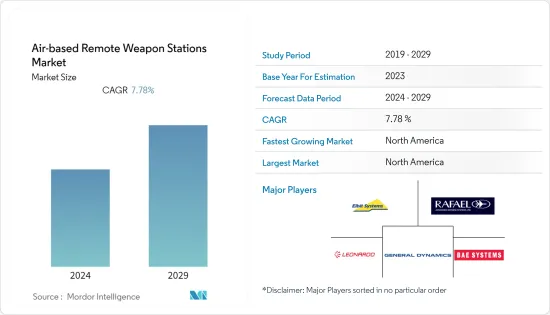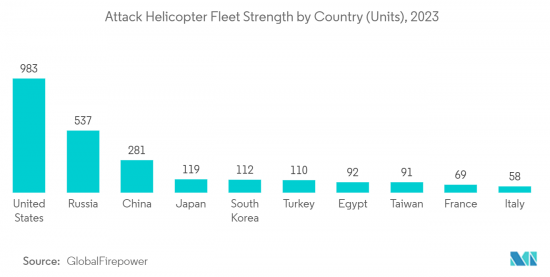
|
시장보고서
상품코드
1406096
항공 기반 RWS : 시장 점유율 분석, 산업 동향과 통계, 성장 예측(2024-2029년)Air-based Remote Weapon Stations - Market Share Analysis, Industry Trends & Statistics, Growth Forecasts 2024 - 2029 |
||||||
항공 기반 RWS 시장은 현재 34억 5,000만 달러로 평가되고 있습니다.
예측 기간 중 CAGR은 7.78%로, 5년 후에는 50억 2,000만 달러에 달할 것으로 예측되고 있습니다.

새로운 기술과 플랫폼은 미국, 러시아, 중국과 같은 국가들의 전쟁 전략을 변화시켰습니다. 이들 국가는 적의 거점에 심각한 영향을 미치고 무력 충돌시 전술적 우위를 확보하는 데 도움이 되는 정교하고 강력한 무기 개발에 주력하고 있으며, RWS는 시각적 우위와 특정 장소를 선제공격할 수 있는 능력으로 인해 현재 전쟁 시나리오에서 광범위하게 사용되고 있습니다. 새로운 센서 기술(시각 시스템) 및 발사 시스템(방향성 에너지 무기와 같은)과 통합된 첨단 원격 무기 스테이션을 개발하기 위한 군와 원격 무기 시스템 제조업체의 투자가 증가함에 따라 향후 수년간 시장 성장을 가속할 것으로 예상됩니다.
그러나 시스템 통합사업자가 페이로드 용량, 공기역학적 프로파일 및 사거리를 손상시키지 않으면서 고급 기능을 제품 포트폴리오에 통합하기 위해 직면한 설계 과제가 시장 진입에 걸림돌이 될 수 있습니다. 설계자는 또한 완전히 작동 가능한 RWS를 개발하기 위해 다른 시스템 제조업체의 고급 옵트로닉 센서 및 하위 시스템과 상호 호환되는 고급 통합 기능의 가용성을 보장해야 하며, 이는 전체 시스템 설계에 복잡한 전망을 제공합니다.
항공 기반 RWS 시장 동향
헬리콥터 부문이 예측 기간 중 시장을 독점
항공 기반 RWS는 주로 헬리콥터에 탑재됩니다. 공격헬기에 탑재되는 RWS의 대표적인 예로는 자동포와 기관포가 있으며, 이들은 단발포신으로 회전식입니다. 많은 국가가 공격헬기 전용기를 보유하고 있으며 다양한 무장을 갖추고 있지만, 실용헬기나 운송헬기에도 RWS를 장착하고 있습니다. 이러한 커스터마이징은 전용 공격 헬리콥터를 조달할 자금이 없는 국가에서 널리 채택되고 있습니다. 사프란의 공중 무기 시스템, 벨 UH-1, Huey II, 212, 412 기종용으로 설계 및 생산된 제너럴 다이내믹스의 UH-1 플랭크 모듈식 헬리콥터 무기 시스템, 에어버스의 HForce 헬리콥터 무기 세트, FN Hastal의 공중 핀틀 마운트 무기 시스템. 레이시온 레이저 무기체계는 현재 사용 중인 원격 조종 무기체계 모델 중 일부입니다.
많은 헬리콥터가 새로운 첨단 무기 시스템으로 업그레이드되고 있습니다. 예를 들어 Sikorsky는 블랙호크 헬리콥터에 대한 새로운 무기 시스템 개조 키트를 개발하여 인증을 획득했습니다. 개발 및 인증 단계에서 테스트된 무기에는 고정식 전방 GAU-19와 M134포가 포함되며, 2022년 10월 미 해군은 13년 동안 사용한 MQ-8B를 퇴역시키고 더 큰 MQ-8C로 교체했습니다. 또한 방향성 에너지 무기와 같은 새로운 기술도 헬리콥터에서 테스트되고 있습니다.

북미, 예측 기간 중 시장 성장세가 두드러짐
긴장과 국경 분쟁이 심화됨에 따라 북미 국가들은 최신 전투기, 헬리콥터 및 무인 항공기 조달을 위해 연간 국방 예산을 늘리고 있습니다. 북미에서는 기존 시스템의 전투 즉시성을 보장하기 위해 안보 위협에 효과적으로 대응하고 긴급하고 중요하며 위험한 전략적 임무를 수행하기 위해 지역 군의 능력을 효과적으로 업그레이드하는 여러 무기 현대화 프로그램이 현재 진행 중입니다.
미국은 북미에서 이러한 무기 시스템의 주요 사용자이며 현재 기존 무기의 업그레이드에 주력하고 있습니다. 또한 미국은 이러한 장비의 중요한 세계 수출국이자 소비국이기도 합니다. 이스라엘, 러시아, 중국과 같은 잠재적 적대국들이 미군과 동맹국 및 파트너의 항공 자산을 위협할 수 있는 다양하고 광범위하며 현대적인 지역 공격형 미사일 시스템을 배치함에 따라 미국 소재 방산업체들은 RWS 포트폴리오의 역량을 적극적으로 확장하고 현대화하고 있습니다. 확장하고 현대화하고 있습니다. 미국 국방부(DoD)는 F-35 통합 타격 전투기(JSF)에 25mm 개틀링 포를 장착하는 것을 목표로 하고 있습니다.
제너럴 다이내믹스에 따르면 4발짜리 25mm 개틀링포는 분당 최대 3,300발을 발사할 수 있으며, 예측 기간 중 여러 대의 F-35 JSF가 인도될 예정이기 때문에 항공기의 공대공 공격과 지상 부대에 대한 근접 항공 지원 임무를 수행할 수 있다고 합니다.
항공 기반 RWS 산업 개요
항공 기반 RWS 시장은 통합되어 있으며, 소수의 기업이 시장에서 큰 점유율을 차지하고 있습니다. 시장의 주요 업체로는 Elbit Systems Ltd, Rafael Advanced Defense Systems Ltd, Leonardo S.p.A, General Dynamics Corporation, BAE Systems plc 등이 있습니다.
원격 무기 시스템(RWS) 제조업체들은 제품 포트폴리오를 늘리기 위해 RWS 개발에 많은 투자를 하고 있습니다. 첨단 센서 시스템과 옵트로닉 장비를 통합함으로써 업체들은 신흥 시장에서 지역적 입지를 확대할 수 있을 것으로 예상됩니다. 또한 이 시장의 지역 업체들은 국내 역량을 개발하기 위해 기술 이전 계약을 체결하고 국제적인 업체들과 협력하고 있습니다. 또한 최종사용자인 방위군의 설계 및 성능 사양을 충족하는 고급 시스템을 개발하기 위해 제조업체 간의 전략적 협력이 증가하고 있습니다. 이는 예측 기간 중 업계 이해 관계자들에게 혜택을 줄 것으로 예상됩니다.
기타 특전 :
- 엑셀 형식의 시장 예측(ME) 시트
- 3개월간의 애널리스트 지원
목차
제1장 서론
- 조사의 전제조건
- 조사 범위
제2장 조사 방법
제3장 주요 요약
제4장 시장 역학
- 시장 개요
- 시장 촉진요인
- 시장 억제요인
- Porter's Five Forces 분석
- 공급 기업의 교섭력
- 구매자·소비자의 교섭력
- 신규 진출업체의 위협
- 대체품의 위협
- 경쟁 기업간 경쟁 강도
제5장 시장 세분화
- 컴포넌트
- 무기
- 시각 시스템
- 플랫폼
- 항공기
- 헬리콥터
- 무인항공기
- 지역
- 북미
- 미국
- 캐나다
- 유럽
- 영국
- 프랑스
- 독일
- 러시아
- 기타 유럽
- 아시아태평양
- 중국
- 인도
- 일본
- 한국
- 기타 아시아태평양
- 기타 지역
- 북미
제6장 경쟁 구도
- 벤더 시장 점유율
- 기업 개요
- BAE Systems plc
- Duke Robotics Inc.
- Elbit Systems Ltd
- FN Herstal
- General Dynamics Corporation
- Leonardo S.p.A.
- Rafael Advanced Defense Systems Ltd.
- Singapore Technologies Engineering Ltd.
- Saab AB
제7장 시장 기회와 향후 동향
KSA 24.01.23
The Air-based remote weapon stations (RWS) market is valued at USD 3.45 billion in the current year. It is expected to reach USD 5.02 billion in five years, registering a CAGR of 7.78% during the forecast period.
New technologies and platforms have transformed the warfare strategies of nations such as the United States, Russia, and China. These countries have diverted their efforts toward developing sophisticated and powerful weapons that can severely impact enemy strongholds and help attain a tactical advantage in case of an armed standoff. RWS is used extensively in current warfare scenarios due to its visual superiority and capability to perform pre-emptive strikes on specific locations. The increasing investments of armed forces and remote weapon systems manufacturers into developing advanced remote weapon stations integrated with new sensor technologies (visual systems) and firing systems (like directed energy weapons) are anticipated to bolster the market's growth in the coming years.
However, the market may be deterred by the design challenges system integrators face to incorporate advanced features in their product portfolio without compromising the payload capacity, aerodynamic profile, and range of a delivery platform. Designers must also ensure the availability of sophisticated integrated features cross-compatibility with the advanced optronic sensors and subsystems from other system manufacturers to develop a fully operational RWS, rendering a complex outlook to the overall system design.
Air-based Remote Weapon Stations Market Trends
Helicopters Segment is Projected to Dominate the Market During the Forecast Period
Airborne remote weapon systems (RWS) are primarily mounted on helicopters. Typical examples of RWS used on attack helicopters include autocannons and machine guns, which are single-barrel and rotating. While many countries have dedicated attack helicopters that possess a wide range of armaments, there are also RWS attached to utility and transport helicopters. These customizations are being widely adopted by countries that lack the funds to procure dedicated attack helicopters. Safran's airborne weapon systems, General Dynamics UH-1 Plank modular helicopter weapon system designed and produced for the Bell UH-1, Huey II, 212, and 412 aircraft, the Airbus HForce helicopter weapons suite, FN Herstal's airborne pintle mounted weapon systems. Raytheon Laser weapon systems are some of the remotely operated weapon system models currently being used.
Many helicopters are being upgraded with new and advanced weapon systems. For instance, Sikorsky developed and certified a new weapons system retrofit kit for the Black Hawk helicopters. The weapons tested during the development and certification phase included fixed-forward GAU-19 and M134 guns, among others. In October 2022, the US Navy recently retired its fleet of MQ-8Bs after 13 years of service and replaced them with the larger MQ-8C. In addition, emerging technologies, like directed energy weapons, are also being tested on helicopters. Such developments will propel the growth of the market in the forecast years.

North America Will Showcase Significant Growth in the Market During the Forecast Period
Amidst escalating tensions and border disputes, countries in North America are increasing their annual defense budget for procurement of the latest combat aircraft, helicopters, and uncrewed aerial vehicles. North America, to ensure combat readiness of existing systems, several weapon modernization programs are currently underway to effectively upgrade the capabilities of the regional armed forces for effectively responding to security threats and accomplishing urgent, critical, and dangerous strategic missions.
The United States is the leading user of such weapon systems in North America and is currently focusing on upgrading its existing armada. Moreover, the country is a critical global exporter and consumer of such equipment. With potential adversaries, such as Israel, Russia, and China, fielding an increasingly diverse, expansive, and modern range of regional offensive missile systems that can threaten the aerial assets of the US forces, its allies, and partners, the US-based defense contractors are actively expanding and modernizing the capabilities of their RWS portfolio. The US Department of Defense (DoD) aims to integrate the 25mm Gatling gun onboard the F-35 Joint Strike Fighter (JSF).
According to General Dynamics Corporation, the four-barrel 25mm Gatling gun can fire up to 3,300 rounds per minute to enable the aircraft to perform air-to-air attacks and close-air-support missions to troops on the ground since there are several F-35 JSFs scheduled for delivery during the forecast period. Such developments will drive the market growth in the coming years.
Air-based Remote Weapon Stations Industry Overview
The air-based remote weapon stations market is consolidated, with a few players holding significant shares in the market. Some prominent players in the market are Elbit Systems Ltd, Rafael Advanced Defense Systems Ltd, Leonardo S.p.A, General Dynamics Corporation, and BAE Systems plc.
Remote weapon systems (RWS) manufacturers invest heavily in developing RWS to increase their product portfolio. Integrating advanced sensor systems and optronic equipment is anticipated to help the companies expand their geographical presence in emerging markets. Also, the regional players in the market are collaborating with international players with technology transfer agreements for developing indigenous capabilities. Furthermore, strategic collaborations between manufacturers are on the rise to develop sophisticated systems that conform to end-user defense forces' design and performance specifications. This is expected to benefit industry stakeholders during the forecast period.
Additional Benefits:
- The market estimate (ME) sheet in Excel format
- 3 months of analyst support
TABLE OF CONTENTS
1 INTRODUCTION
- 1.1 Study Assumptions
- 1.2 Scope of the Study
2 RESEARCH METHODOLOGY
3 EXECUTIVE SUMMARY
4 MARKET DYNAMICS
- 4.1 Market Overview
- 4.2 Market Drivers
- 4.3 Market Restraints
- 4.4 Porter's Five Forces Analysis
- 4.4.1 Bargaining Power of Suppliers
- 4.4.2 Bargaining Power of Buyers/Consumers
- 4.4.3 Threat of New Entrants
- 4.4.4 Threat of Substitute Products
- 4.4.5 Intensity of Competitive Rivalry
5 MARKET SEGMENTATION
- 5.1 Component
- 5.1.1 Weaponry
- 5.1.2 Vision Systems
- 5.2 Platform
- 5.2.1 Aircraft
- 5.2.2 Helicopters
- 5.2.3 Unmanned Aerial Vehicles
- 5.3 Geography
- 5.3.1 North America
- 5.3.1.1 United States
- 5.3.1.2 Canada
- 5.3.2 Europe
- 5.3.2.1 United Kingdom
- 5.3.2.2 France
- 5.3.2.3 Germany
- 5.3.2.4 Russia
- 5.3.2.5 Rest of Europe
- 5.3.3 Asia-Pacific
- 5.3.3.1 China
- 5.3.3.2 India
- 5.3.3.3 Japan
- 5.3.3.4 South Korea
- 5.3.3.5 Rest of Asia-Pacific
- 5.3.4 Rest of the World
- 5.3.1 North America
6 COMPETITIVE LANDSCAPE
- 6.1 Vendor Market Share
- 6.2 Company Profiles
- 6.2.1 BAE Systems plc
- 6.2.2 Duke Robotics Inc.
- 6.2.3 Elbit Systems Ltd
- 6.2.4 FN Herstal
- 6.2.5 General Dynamics Corporation
- 6.2.6 Leonardo S.p.A.
- 6.2.7 Rafael Advanced Defense Systems Ltd.
- 6.2.8 Singapore Technologies Engineering Ltd.
- 6.2.9 Saab AB










